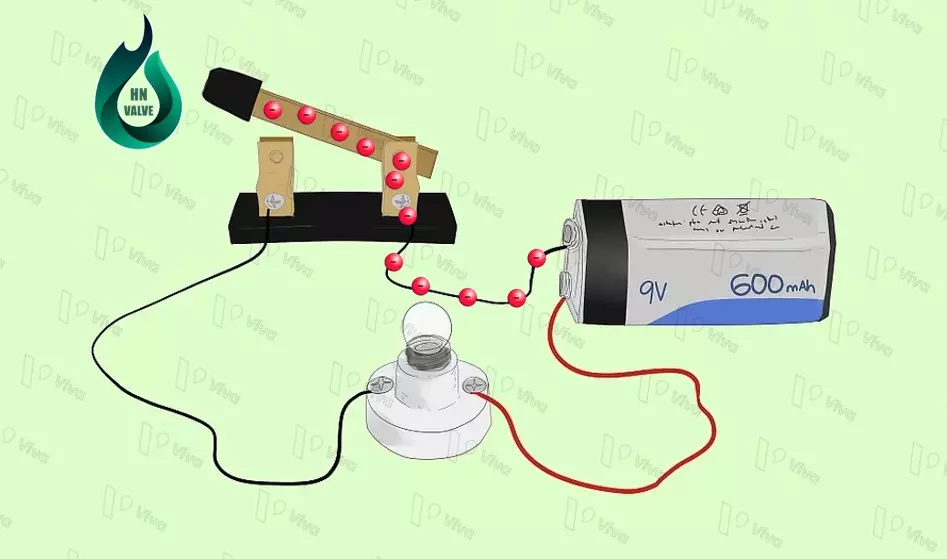Current Intensity
Current intensity is a term that most people have heard of, but understanding current and related concepts can be challenging because we cannot see it with our eyes, and it is dangerous to try to perceive it through touch.
In this article, I will try to clarify the concept of current intensity in the simplest way possible so that, after reading this, we can understand the essence and significance of current intensity.
Problem Statement
As you may know, electric current in a conductor is essentially the movement of electrons within that conductor. In its normal state, these electrons do not move much along the length of the conductor, which means there is no current inside the conductor.
To create a current in a conductor, the simplest method is to use a direct current source (e.g., a battery) and connect the two ends of the conductor to the two terminals of the battery. To limit the energy release capability of the battery, we add a hairpin light bulb in the circuit.
Once the connections are completed, electrons from the negative terminal of the battery flow into the conductor, then through the light bulb, and return to the positive terminal. The more electrons move through the cross-section of the conductor, the brighter the light bulb gets, and vice versa. Current intensity is used to evaluate the amount of electrons flowing through the conductor within a given time, whether it is large or small.

Definition and Measurement Unit of Current Intensity
Definition
Current intensity is a quantity used to assess the strength or weakness of a current flowing through a conductor. It is calculated as the ratio of the amount of electric charge passing through a cross-section of the conductor over a unit of time.
Therefore, a higher current intensity indicates a greater amount of electric charge passing through the cross-section of the wire or conductor, resulting in a stronger current, and vice versa.
The mathematical formula to calculate current intensity is:
I = Q / t
Where:
- (I) is the current intensity, measured in Amperes (A).
- (Q) is the electric charge, measured in Coulombs (C).
- (t) is the time, measured in seconds (s).
The current intensity can vary depending on the power source and the impedance of the electrical circuit, and it is regulated through components such as power sources, resistors, capacitors, inductors, and other components in the circuit.

Measurement Unit of Current Intensity
The measurement unit of current intensity in the International System of Units (SI) is Ampere (A). Ampere is the measurement unit for the amount of electric charge passing through a point in an electrical circuit in one second. One Ampere is equivalent to one Coulomb (C) passing through a point in an electrical circuit in one second.
The unit “Ampere” is named after the French physicist André-Marie Ampère, who made significant contributions to the field of electromagnetism and electrodynamics in the 19th century.

Significance of Current Intensity
Current intensity holds great significance in various fields related to electrical power (electronics, electromechanics, power generation, etc.). This is evident through the inclusion of current intensity ratings on electrical devices such as sockets, plugs, and other equipment.
Some important significances of current intensity include:
- Operation of electrical devices: Current intensity determines the performance and operation of electrical devices such as light bulbs, computers, industrial machinery, electronic devices, and many other systems. These devices are designed to operate within a specific current intensity range to ensure proper functionality and reliability.
- Calculation and engineering: Current intensity is used in calculations and engineering related to electrical circuits, electronics, and electromagnetism. It is an important parameter for calculating resistance, power, efficiency, and electromagnetic interactions between components.
- Safety: Current intensity is closely related to safety and protection in electrical systems. Monitoring and controlling current intensity help prevent overload, short circuits, fires, and other electrical incidents, ensuring safety for users and safeguarding equipment and systems.
Classification of Current Intensity
Root Mean Square (RMS) Current Intensity
Root Mean Square (RMS) current intensity is a value used to measure the intensity of a time-varying current, such as alternating current (AC). RMS current intensity is the effective value of the current, meaning the current value that produces the same heat effect as the direct current (DC) creating the same power in a resistive load.
The formula for calculating RMS current intensity depends on the type of current and time. Below is the formula for calculating RMS current intensity for alternating current (AC):
I(RMS) = (1/√2) × I(peak)
Where:
- I (RMS) is the RMS current intensity.
- I (peak) is the peak value of the current intensity in a cycle.
RMS current intensity allows for the calculation of power consumption and estimation of the impact of the current on components in an electrical circuit. It is an important value in designing and evaluating the performance of electrical devices and systems.
Rated Current Intensity
Rated current intensity is the value of current intensity at which a device, electrical circuit, or system is designed to operate stably and safely. It represents the maximum value that the device or system can withstand without causing malfunctions, damages, or undesired effects.
Rated current intensity is usually determined by the manufacturer or specified in technical standards. It is often expressed in units of Ampere (A) and may be indicated on the label attached to the device or published in accompanying technical documentation.
Determining the rated current intensity is essential to ensure that the device or system being used does not exceed the safe limits. When selecting and using electrical equipment, it is important to adhere to the rated current intensity to ensure that the current does not exceed this limit, thus avoiding situations of overload, fire hazards, damages, or risks to people and property.
Laws Related to Current Intensity
Ohm’s Law
Ohm’s Law describes the relationship between voltage (V), current intensity (I), and resistance (R) in an electrical circuit.
The law is formulated as follows:
The current flowing through a conductor is directly proportional to the voltage and inversely proportional to the resistance.
Formula: I = V / R
Where:
- I is the current intensity (ampere).
- V is the applied voltage (volt) across the circuit.
- R is the resistance (ohm) of the circuit.
Kirchhoff’s First Law (Kirchhoff’s Current Law – KCL)
Kirchhoff’s First Law states that the total current entering a node (junction) in an electrical circuit is equal to the total current leaving the node. This means that the current intensity at a node in the circuit remains constant.
Kirchhoff’s Second Law (Kirchhoff’s Voltage Law – KVL)
Kirchhoff’s Second Law states that the total voltage around a closed loop (electric circuit) is equal to the sum of the voltages across the components within the loop. This means that the total sum of voltage drops across the components in a closed loop must be zero.
Devices for Measuring Current Intensity
There are several types of devices used to measure current intensity in an electrical circuit. Here are some common measuring devices:
- Ammeter: This device directly measures the current intensity in the circuit. The ammeter is connected in series with the circuit and measures the current intensity value, which is displayed on a screen. There are two types of ammeters: analog and digital.
- Current shunt: This is a component with low resistance inserted into the circuit to reduce the current intensity and generate a smaller, measurable current value using an ammeter or current meter.
- Current clamp meter: This device has the ability to measure current intensity without cutting the circuit. It uses the principle of a current transformer to measure the current intensity based on the electromagnetic induction principle.
- Hall Effect current sensor: This measuring device utilizes the Hall Effect to measure current intensity. It has a Hall sensor placed near the current-carrying conductor to measure the magnetic field effect of the current and determine the current intensity.

